In this guest blog, artist Guy Schofield talks about Richmal Mangnall: Q&A, a new display exploring Richmal Mangnall's life through digital art and AI. The display was co-created with a group of young people over a series of digital arts workshops.
Read on to go behind the scenes - and see what ChatGPT has to say about the future of education!
Richmal Mangnall (1769-1820) was originally a pupil at Crofton Hall school and
became a teacher there in the 1790s. As well as teaching hundreds of young people,
she also wrote the textbook Historical and Miscellaneous Questions for the Use of Young
People. At first,
the book was just intended for use at the school in Crofton. However, it went on to become an
influential textbook used at schools across the country. By 1857, it had
reached 84 editions. ‘Mangnall’s Questions’ was
referenced by many influential writers and social commentators, including
Charles Dickens, Elizabeth Gaskell, and James Joyce.
The book was made up of a series of questions and answers in
which Mangnall covered geography, science, literature and religion. This might
seem strange to us now but in the late 18th century, learning by
rote (memorising facts and figures) was a common way of educating young people.
In this project, a group of young people from Wakefield and
surrounding areas worked with artist Guy Schofield to think, talk and make art
about Mangnall’s life and ideas. We thought about how the concept of asking and
answering precise questions and answers connects with the modern world,
especially in fields such as education, coding, and AI. We also discussed how
women’s roles have changed in teaching and learning since Mangnall’s time. Over
several sessions we made digital artworks using a range of different
techniques.
%20edit.png) |
| Guy Schofield working with the young participants at one of the Digital Arts Workshops |
Session 1: Saturday 7 January 2023
We started the project by talking about Richmal Mangnall’s
life and work. Mangnall became a teacher at a time when women were expected to
take care of children and the home. Very few women were able to work in
professional jobs and teaching was one of the few careers available to them.
We also talked about Mangnall’s Questions and how learning
by rote compares to the young people’s experience of school. We thought about
fields where precise questions and answers are still very important, such as
coding.
After discussing the idea of learning by instruction, we
wrote programs to instruct a computer to draw digital self portraits. Each of
the lines and shapes in these images is defined by a line of code. Some of the
images relate to ideas about education and Mangnall’s life. Others represent
objects we felt were significant to us. For example, Evie chose to experiment
with abstract shapes, while Owen made an image of his PlayStation 1.
 |
| Evie's digital artwork experimenting with abstract shapes. |
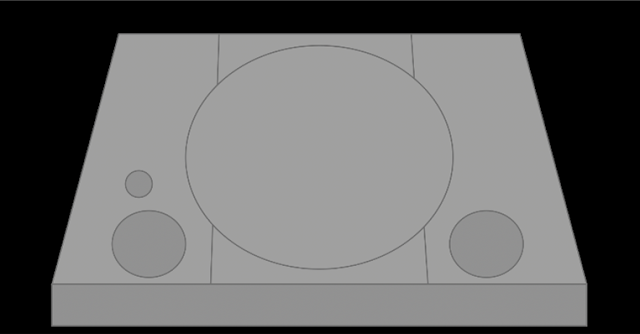 |
| Owen's digital artwork of his PlayStation 1. |
Session 2: Saturday 21 January 2023
Following the work in the previous session, we thought about
how questions and answers are important in different types of programming. We
rewrote a slitscan program in the programming language Processing, to store
images of different sizes. Slitscans are long-exposure images in which a moving
line of pixels is recorded over time. The young people captured slitscans of
objects from Wakefield Museum including several relating to Richmal Mangnall’s life.
 |
| A slitscan image of the Cameron motorcycle built by Amy Gill's father, on display at Wakefield Museum |
We also talked about art in Mangnall’s time and how
important people were celebrated through statues and paintings. We used the
photogrammetry app Polycam on a mobile phone to make ‘virtual statues’ representing
ideas from the workshops. Photogrammetry involves using a computer to make 3D
models of objects from hundreds of photographs. Archaeologists and engineers
use photogrammetry to make accurate digital measurements of landscapes and
objects. We put the statues into a virtual art gallery using 3D software
Blender.
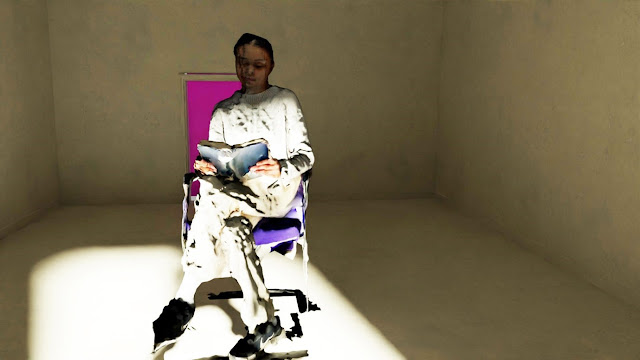 |
| A virtual statute of one of the young participants created in Polycam, on display on a virtual art gallery |
Session 3: Saturday 28 January 2023
We started the session talking about how Artificial
Intelligences such as DALL-E and ChatGPT are in the news at the moment.
Artificial Intelligence (AI) is being used more and more in a range of
technologies, from social media to medicine. We experimented with two different
AIs to make artworks.
We asked OpenAI.com’s DALL-E2 to make images relating to Richmal Mangnall and the themes of the exhibition. The images produced by AIs are based on a limited understanding of the world and often include nightmarish misunderstandings of the shapes of objects. We asked DALL-E2 to make images from the following prompts:
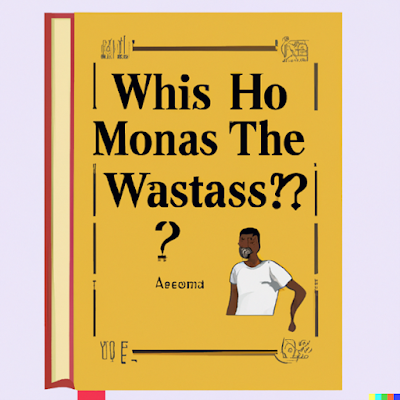 |
| DALLE-2's image from the prompt 'The cover of the book 'Historical and Miscellaneous Questions for the Use of Young People'' |
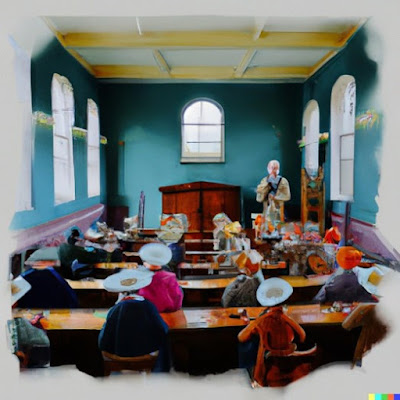 |
| DALLE-2's image from the prompt 'Crofton Hall Schoolroom from the 18th century in watercolour with students including one wearing a dunces cap, with no teacher' |
We also tried to make DALL-E2 create an image of Richmal Mangnall by describing her in prompts. We found that the AI assumed that Mangnall was male, which showed how AIs can reproduce the biases and prejudices in the information they work with.
 |
| A DALLE-2 image responding to the prompt 'Richmal Mangnall', and assuming she was male |
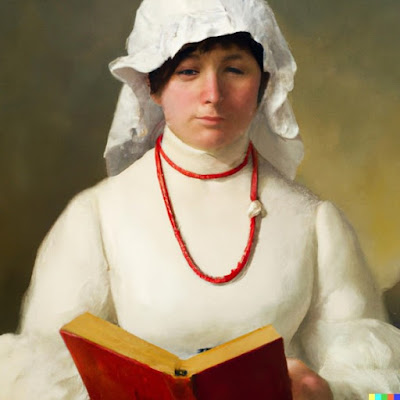 |
| A DALLE-2 image responding to prompts trying to recreate the oil painting of Richmal Mangnall - this one is much closer! |
Working with ChatGPT
ChatGPT is a chatbot: an Artificial Intelligence designed
to have conversations with human beings. Taking the idea of simple questions
and answers, we asked ChatGPT what it knew about Richmal Mangnall and about
education in the past and future. We found that ChatGPT could produce quite
convincing statements about education…
“It is difficult to predict exactly how education will
change in the next 250 years, as it will likely be influenced by a variety of
factors such as technological advancements, societal changes, and shifts in
global priorities.”
….but that it struggled with basic information about human
beings. When we asked about Richmal Mangnall, it confused her with the author
Richmal Crompton and said that she wrote several books after her own death!
The last part of the workshop was spent planning the
exhibition. The young people thought about how to use sustainable materials
wherever possible and made mock-ups of the display case, using prints of the
artwork they had made.
Highlights
The
thing I enjoyed most about the project was how enthusiastic the young people
were. They were really courageous in tackling big ideas around education,
diversity and AI.
The
young people took a really active part in the design of the exhibition and had
some great ideas about how to display the work they had made in a three
dimensional space.
You can watch the unveiling of 'Richmal Mangnall: Q&A' by some of the young participants, with an introduction from Curator John Whitaker, below:
Richmal Mangnall: Q&A is now on display in the Wakefield One atrium until late September 2023.
The atrium case is just outside of Wakefield Museum, up the stairs in the wider Wakefield One building. Click here for access and visitor information at Wakefield Museum.
Want to learn more? Join us on Thursday 27 April for our Online Talk - Richmal Mangnall: Q&A with Guy Schofield and John Whitaker!


No comments:
Post a Comment
We would love your comments - though they may take a day or two to appear.